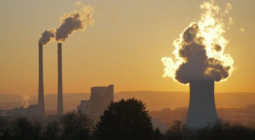This map shows every one of the world’s remaining coal power plants.

There are more than 4,000 coal power plants globally. Now you can track every one and see if they’re closing—or if countries are adding more.
Over roughly a decade, 256 coal power plants in the U.S. have closed. During the Trump administration, more coal power capacity was retired than during any other presidency, despite Trump’s rhetoric about saving the industry. Another 58 plants are on track to be retired by 2030. But at the same time, new coal plants continue to be built in countries such as India and China.
A new map shows the location of the world’s 6,601 coal-burning units (there are 4,000-plus power plants, many with multiple units). The dashboard, called the Bloomberg Coal Countdown, is tracking the plants as countries move to new plans for cleaner energy. Right now, a third of the world’s carbon emissions come from burning coal, more than any other source. “Phasing out coal is definitely the most important thing we should do in order to protect the climate,” says Ailun Yang, who leads international initiatives for Bloomberg Philanthropies’ Global Climate and Environment Program. The UN secretary-general recently said the same thing, calling for all planned coal projects to be canceled.

*[Screenshot: Bloomberg Coal Countdown]
In the past, it was difficult to track the industry in one place. The nonprofit worked with the Powering Past Coal Alliance and research organizations to gather data about current and planned coal plants. The dashboard also puts the numbers in context. “We try to bring in additional analysis,” Yang says. “What do these coal power plants mean for climate change? What’s the implication if they all get built? What’s the implication if we can get rid of them in order to achieve our climate protection goals?”
Right now, China has the most coal power in the world, with 1,042 gigawatts of operational capacity. Roughly a decade ago, the country was adding two or three new plants a week. That pace has dramatically slowed, though the map shows dozens of newly planned coal plants in the pipeline. It remains to be seen if those plans will be scrapped, as the country now aims to get to net-zero emissions by 2060. “If China is serious about meeting that target, then of course they can’t build any new coal power plants,” Yang says. “That will be going the other direction of their commitment.”
China is also funding new coal plants in other countries in Southeast Asia, Africa, and Eastern Europe, even as the Chinese government talks about the clear need to address climate change. “We don’t want to see double standards,” she says. “China is also the world’s leader in clean energy—wind and solar—and should also help these countries benefit from these renewable energies as well.”
The low cost of new wind and solar plants means that it’s completely feasible to phase out coal, though the coal industry and some government decisions are slowing progress. The transition also has to happen in an equitable way, Yang says, so anyone who worked in the coal industry can be supported in well-paying new jobs. But it’s possible that the last coal plants could close by 2040, if not much earlier. “As we launch the countdown, we really can be looking at the number coming down,” she says. “In our lifetime, we will see that number, which right now stands at 4,000-something, actually come down to zero.”
4 March 2021
FAST COMPANY




